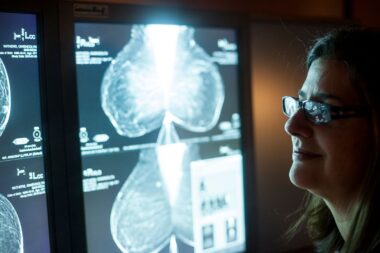One in eight women will develop breast cancer in her lifetime. Given the prevalence of breast cancer, it is important for women to understand the significant role that early detection plays in diagnosis, treatment and survivorship. Breast cancer often has no symptoms until it is more advanced, which is why annual screening mammograms are vital to early detection. Annual 3D mammography can help detect breast cancers up to three years before a lump can be felt during a breast self-exam or a clinical breast exam. Women diagnosed in the earliest stages (stage 0 or stage 1) and while cancer is confined to the breast typically require less invasive treatments and have a significantly higher chance of survival.
Simply put, early detection through annual screening saves more lives.
Breast Cancer: Understanding the Basics
Breast cancer often forms in the cells of the breast’s milk ducts. These cancer cells multiply out of control and can spread to other tissues in the body. The two most common types of breast cancer are:
- Invasive ductal carcinoma, diagnosed in about 80% of women with breast cancer, where cancer cells begin in the ducts (tubes that carry milk to the nipple) and can then grow outside the ducts to other parts of the breast tissue, and in more advanced stages, to other parts of the body.
- Invasive lobular carcinoma, diagnosed in about 10% of women with breast cancer, where cancer cells begin in the lobules (glands that produce milk) and can then spread to nearby breast tissue, and in more advanced stages, to other parts of the body.
There are several other less common kinds of breast cancer as well.
The two biggest risk factors for developing breast cancer are being a woman and aging. Other risk factors include having dense breasts, mutations to certain genes (like BRCA 1 or BRCA 2), or having a personal or family history of breast or ovarian cancer. Understanding your personal risk factors for breast cancer can help to inform your breast health plan, including mammography.
Read More: 8 Common Breast Cancer Myths Debunked
Breast Cancer Stages: Explained
Leading cancer organizations refer to the National Cancer Institute’s Surveillance, Epidemiology, and End Results program database to classify breast cancer into three categories: localized, regional and distant. A breast cancer’s particular classification (type) and how early cancer is detected (stage) help physicians determine what kind of treatment may be most effective.
- Localized cancer is contained within the breast, typically Stage 0 cancer and has a 99% five-year survival rate. Some types of Stage 1 cancers are considered localized with a similar survival rate, although some will progress to regional cancer.
- Regional cancer has spread from the breast to other nearby sites. It has an 86% five-year survival rate. Stages 2 and 3 are considered regional.
- Distant cancer, also known as metastatic breast cancer, has spread throughout the body and has a five-year survival rate of 30%. Stage 4 is metastatic cancer.
Annual Screening Mammograms and Early Detection
Annual screening mammograms are a critical component of maintaining breast health over time and helping to detect cancer in its earliest stages. For women of average risk for developing breast cancer, annual screening mammograms are recommended starting at age 40. For women at higher risk, breast expert guidelines recommend starting screening mammography earlier to establish a baseline. In addition to annual screening, diagnostic 3D mammography, breast MRI and/or breast ultrasound may also be part of breast health surveillance for high-risk patients. Talk to your healthcare provider about your health and family history and any potential risk factors in order to determine a plan that’s right for you.
Read More: The Best Thing I Did Was Get My Annual Mammogram
Be Breast Aware
Routine monthly self-exams and clinical exams during your yearly well visit can also help you to become more “breast aware” and familiar with the look and feel of your breasts. These regular examinations can help you determine what may be normal for you or what may require further attention from your doctor.
Although self-exams do not take the place of annual screening mammograms, they can signal changes that may warrant additional attention. You should do a visual and physical breast self-exam at the same time each month — usually three to five days after your period starts — so your breasts aren’t as tender.
Breast health can change with hormonal changes (monthly menstrual cycle, pregnancy, menopause, hormone replacement therapy) and as women age. So, sometimes “normal” is hard to evaluate over time. Also, most women with early-stage breast cancer will never develop visible or palpable symptoms until later stages. That is why being vigilant is critical. Some breast health changes to watch out for include:
- A breast or armpit lump
- Breast pain
- Breast swelling or thickening
- Changes to the breast’s appearance
- Dimpling or irritation in the breast skin
- Discharge from the nipple that’s not breast milk
- Pain or pulling in at the nipple
- Red or flaky nipples or breast skin
If you observe any of these changes, it’s important to consult with your physician to be further evaluated.
Diagnostic Mammograms and Advanced Imaging
Annual screening mammograms help your healthcare provider monitor breast health changes (including breast density) that occur naturally year over year. You may be referred by your physician for a diagnostic mammogram if a breast change or concern was detected during an annual screening mammogram and you are called back for further evaluation. It’s natural to worry about a call back, but to put it in context, about 9% of women are recalled and fewer than 1% will be found to have breast cancer. Chances are much greater that you will not have breast cancer and can return to routine annual screening after that.
During a diagnostic mammogram, other imaging tests may be used to help further evaluate a change or concern. Advanced imaging technologies used in a diagnostic workup include 3D mammography, breast MRI, breast ultrasound and needle biopsy. The results of your diagnostic imaging will be reported to your physician and provided to you. If breast cancer is confirmed through diagnostic imaging and pathology results, a patient navigator will reach out to review the results with you and outline the next steps to facilitate follow-up with a specialist.
Raising Awareness and Maintaining Annual Screening Mammograms
Breast health and breast cancer awareness are important throughout the year, not just during Breast Cancer Awareness Month in October. Remember that early detection is key to finding and fighting breast cancer and saving more lives. If you are due or past due for your annual screening, schedule your annual mammogram and remind the women in your life to do the same. Find your reason to prioritize your breast care.



